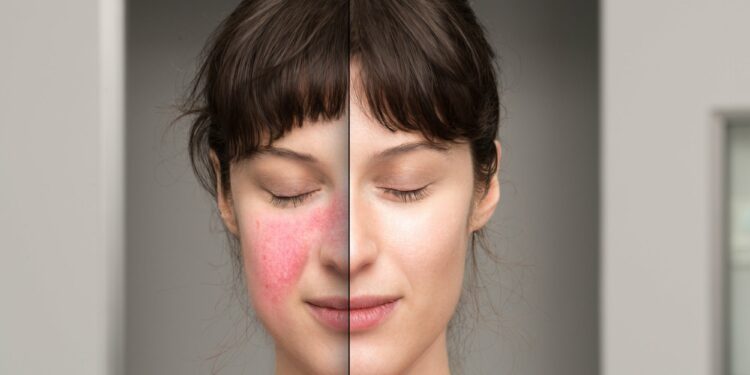Rosacea most often affects women between the ages of 30 and 60, which includes the average age most women begin menopause in the US. Unfortunately, the hot flashes that come with menopause may be enough to trigger a rosacea flare-up.
Ainsi, Can you develop rosacea in menopause? Women are more likely than men to develop rosacea, especially during menopause. However, the condition tends to be more severe in men. The signs and symptoms of rosacea tend to erupt from time to time, appearing for weeks to months and then diminishing for a while. Over time, the symptoms may persist indefinitely.
Does perimenopause make your face red? The loss of estrogen can show on your skin starting in perimenopause, which is the period leading up to menopause when hormone levels start to decline. During this time, your body becomes more sensitive to temperature. You may have episodes in which you suddenly feel hot and sweaty, and your face gets red and flushed.
de plus, Does antihistamine help rosacea? Avoidance of triggering foods would be the best way to avoid rosacea flares, but an antihistamine like Claritin, Allegra or Zyrtec taken an hour prior to food exposure could assist in minimizing rosacea flareup!
What are the symptoms of low estrogen?
10 symptoms of low estrogen
- Breast tenderness. Sore breasts are a telltale sign of low estrogen that’s normal. …
- Fatigue and sleep issues. …
- Irregular menstrual cycles. …
- Disappearing menstrual cycles. …
- Mood swings and depression. …
- Headaches. …
- Hot flashes and night sweats. …
- Frequent urinary tract infections.
Does the menopause give you a red face? Women in menopause can experience hot flashes as often as several times a day. But this experience can vary from one woman to the next and may include: Sudden warm feelings or sweating. Redness of the face, neck, ears, chest, or other areas.
What are signs of perimenopause? Symptoms
- Irregular periods. …
- Hot flashes and sleep problems. …
- Mood changes. …
- Vaginal and bladder problems. …
- Decreasing fertility. …
- Changes in sexual function. …
- Loss of bone. …
- Changing cholesterol levels.
What is the age for perimenopause? Perimenopause can begin in some women in their 30s, but most often it starts in women ages 40 to 44. It is marked by changes in menstrual flow and in the length of the cycle. There may be sudden surges in estrogen.
Can low estrogen cause red face?
Symptoms of low estrogen
Your face may look flushed. Hot flashes while you are sleeping are called night sweats. Mood swings are another effect of low estrogen. You may feel sad, anxious, or frustrated.
Why did I suddenly develop rosacea? Anything that causes your rosacea to flare is called a trigger. Sunlight and hairspray are common rosacea triggers. Other common triggers include heat, stress, alcohol, and spicy foods. Triggers differ from person to person.
Why do I suddenly have rosacea?
The cause of rosacea is unknown, but it could be due to an overactive immune system, heredity, environmental factors or a combination of these. Rosacea is not caused by poor hygiene and it’s not contagious. Flare-ups might be triggered by: Hot drinks and spicy foods.
Do probiotics help with rosacea? Probiotics may help control rosacea flare-ups and symptoms, studies suggest. « Probiotic extracts in conjunction with medication can reduce the redness seen in rosacea, and also improve and strengthen the skin barrier to reduce its stinging, burning and dryness, » Bowe said. Anti-aging.
Can estrogen cause acne?
For women, hormonal changes relating to pregnancy or the menstrual cycle can also trigger acne. Falling estrogen levels may increase the risk of acne around menopause.
How can I raise my estrogen levels quickly?
Food
- Soybeans. Soybeans and the products produced from them, such as tofu and miso, are a great source of phytoestrogens . …
- Flax seeds. Flax seeds also contain high amounts of phytoestrogens. …
- Sesame seeds. Sesame seeds are another dietary source of phytoestrogens.
What vitamins can increase estrogen? 7 Ways You Can Boost Estrogen Naturally
- Phytoestrogen-Rich Foods. Phytoestrogens, found in plants and plant-based foods, have a similar structure to estradiol, which is the strongest of the estrogen hormones. …
- B Vitamins. …
- Vitamin D. …
- Chasteberry (also known as Vitex Agnus-Castus) …
- Boron. …
- Black Cohosh. …
- Evening Primrose Oil.
How can I treat hormonal acne? How do I treat hormonal acne?
- Blackheads and whiteheads: Topical cream (tretinoin).
- Inflammatory acne: Topical retinoid and/or topical antibiotic and/or benzoyl peroxide.
- Moderate to severe acne: Antibiotic and/or isotretinoin (retinoid).
- Cystic acne: Steroid injection (intralesional triamcinolone).
What causes menopausal acne?
The etiology of menopausal acne is multifactorial, with hormonal imbalance being the major culprit. There is a relative increase of androgens in the menopausal female that leads to clinical hyperandrogenism manifesting as acne, hirsutism and androgenetic alopecia.
How can I increase my estrogen levels naturally? Food
- Soybeans. Soybeans and the products produced from them, such as tofu and miso, are a great source of phytoestrogens . …
- Flax seeds. Flax seeds also contain high amounts of phytoestrogens. …
- Sesame seeds. Sesame seeds are another dietary source of phytoestrogens.
What are the 34 signs of perimenopause?
What Are the Signs of Perimenopause?
- Hot flashes.
- Breast tenderness.
- Worse premenstrual syndrome.
- Lower sex drive.
- Fatigue.
- Irregular periods.
- Vaginal dryness; discomfort during sex.
- Urine leakage when coughing or sneezing.
What are five of the most common symptoms of perimenopause? 5 Perimenopause Symptoms to Watch For
- Hot Flashes and Night Sweats. One of the most common symptoms that perimenopausal women experience is hot flashes. …
- Worsened PMS and Irregular Menses. …
- Mood swings. …
- Vaginal Dryness and Lowered Sex Drive. …
- Weight Gain and Loss of Bone Density.
What is the average age to start perimenopause?
A period called perimenopause usually begins a few years before the last menstrual cycle. There are two stages in the transition: Early Stage. Perimenopause can begin in some women in their 30s, but most often it starts in women ages 40 to 44.
How can I balance my hormones during perimenopause? As you enter perimenopause, there are a few things you can do to stay healthy and relieve symptoms:
- Quit smoking if you smoke cigarettes.
- Exercise regularly.
- Eat more protein, omega-3 fatty acids, fiber, and calcium.
- Limit saturated fats, highly refined carbs, and sugar.
- Limit caffeine and alcohol.
N’oubliez pas de partager l’article !





Discussion about this post